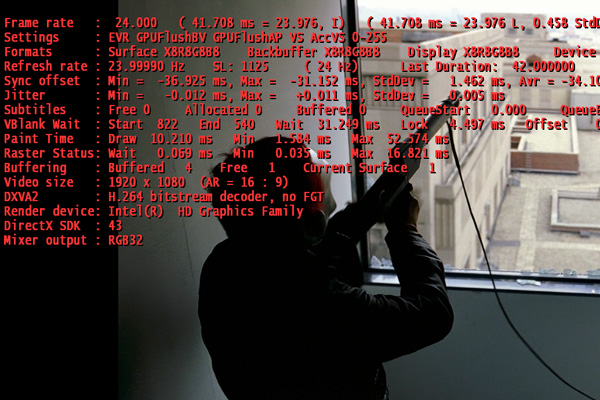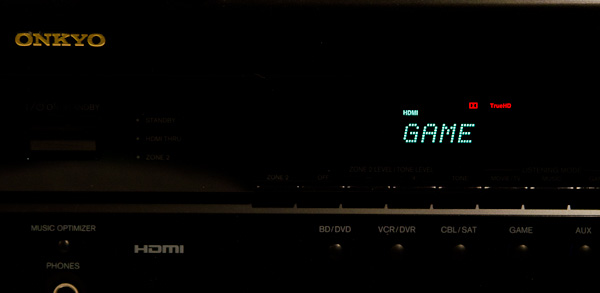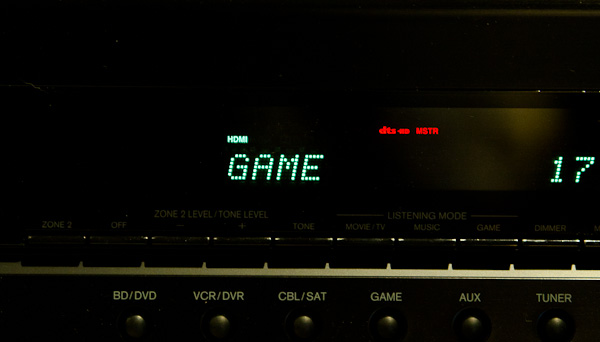The Sandy Bridge Review: Intel Core i7-2600K, i5-2500K and Core i3-2100 Tested
by Anand Lal Shimpi on January 3, 2011 12:01 AM ESTA Near-Perfect HTPC
Since 2006 Intel’s graphics cores have supported sending 8-channel LPCM audio over HDMI. In 2010 Intel enabled bitstreaming of up to eight channels of lossless audio typically found on Blu-ray discs via Dolby TrueHD and DTS-HD MA codecs. Intel’s HD Graphics 3000/2000 don’t add anything new in the way of audio or video codec support.
Dolby Digital, TrueHD (up to 7.1), DTS, DTS-HD MA (up to 7.1) can all be bitstreamed over HDMI. Decoded audio can also be sent over HDMI. From a video standpoint, H.264, VC-1 and MPEG-2 are all hardware accelerated. The new GPU enables HDMI 1.4 and Blu-ray 3D support. Let’s run down the list:
Dolby TrueHD Bitstreaming? Works:
DTS HD-MA bitstreaming? Yep:
Blu-ray 3D? Make that three:
How about 23.976 fps playback? Sorry guys, even raking in $11 billion a quarter doesn’t make you perfect.
Here’s the sitch, most movie content is stored at 23.976 fps but incorrectly referred to as 24p or 24 fps. That sub-30 fps frame rate is what makes movies look like, well, movies and not soap operas (this is also why interpolated 120Hz modes on TVs make movies look cheesey since they smooth out the 24 fps film effect). A smaller portion of content is actually mastered at 24.000 fps and is also referred to as 24p.
In order to smoothly playback either of these formats you need a player and a display device capable of supporting the frame rate. Many high-end TVs and projectors support this just fine, however on the playback side Intel only supports the less popular of the two: 24.000Hz.
This isn’t intentional, but rather a propagation of an oversight that started back with Clarkdale. Despite having great power consumption and feature characteristics, Clarkdale had one glaring issue that home theater enthusiasts discovered: despite having a 23Hz setting in the driver, Intel’s GPU would never output anything other than 24Hz to a display.
The limitation is entirely in hardware, particularly in what’s supported by the 5-series PCH (remember that display output is routed from the processor’s GPU to the video outputs via the PCH). One side effect of trying to maintain Intel’s aggressive tick-tock release cadence is there’s a lot of design reuse. While Sandy Bridge was a significant architectural redesign, the risk was mitigated by reusing much of the 5-series PCH design. As a result, the hardware limitation that prevented a 23.976Hz refresh rate made its way into the 6-series PCH before Intel discovered the root cause.
Intel had enough time to go in and fix the problem in the 6-series chipsets, however doing so would put the chipset schedule at risk given that fixing the problem requires a non-trivial amount of work to correct. Not wanting to introduce more risk into an already risky project (brand new out of order architecture, first on-die GPU, new GPU architecture, first integrated PLL), Intel chose to not address it this round, which is why we still have the problem today.

Note the frame rate
What happens when you try to play 23.976 fps content on a display that refreshes itself 24.000 times per second? You get a repeated frame approximately every 40 seconds to synchronize the source frame rate with the display frame rate. That repeated frame appears to your eyes as judder in motion, particularly evident in scenes involving a panning camera.
How big of an issue this is depends on the user. Some can just ignore the judder, others will attempt to smooth it out by setting their display to 60Hz, while others will be driven absolutely insane by it.
If you fall into the latter category, your only option for resolution is to buy a discrete graphics card. Currently AMD’s Radeon HD 5000 and 6000 series GPUs correctly output a 23.976Hz refresh rate if requested. These GPUs also support bitstreaming Dolby TrueHD and DTS-HD MA, while the 6000 series supports HDMI 1.4a and stereoscopic 3D. The same is true for NVIDIA’s GeForce GT 430, which happens to be a pretty decent discrete HTPC card.
Intel has committed to addressing the problem in the next major platform revision, which unfortunately seems to be Ivy Bridge in 2012. There is a short-term solution for HTPC users absolutely set on Sandy Bridge. Intel has a software workaround that enables 23.97Hz output. There’s still a frame rate mismatch at 23.97Hz, but it would be significantly reduced compared to the current 24.000Hz-only situation.
MPC-HC Compatibility Problems
Just a heads up. Media Player Classic Home Cinema doesn't currently play well with Sandy Bridge. Enabling DXVA acceleration in MPC-HC will cause stuttering and image quality issues during playback. It's an issue with MPC-HC and not properly detecting SNB as far as I know. Intel has reached out to the developer for a fix.














283 Comments
View All Comments
samrty22331 - Wednesday, June 1, 2011 - link
visual studio 2010 professional not supported intel i5 2500kso
can you say
how to install vs 2010 in this
Okurka - Saturday, August 13, 2011 - link
The base clock of the HD 3000 GPU is 1100 MHz, not 850 MHz.That makes the 1550 MHz an overclock of 40,9 %, not 82,4 % as stated in the article.
khalnayak - Sunday, January 22, 2012 - link
I am having Intel HD 3000 - Sandy Bridge in my system and i was willing to get the game called "oil rush" but then i have found weird response for the game here http://www.futurehardware.com/pc-gaming/288.htm , so i just wanted to know is there any one who have tested the Intel HD 3000 - Sandy Bridge for oil rush, any help for this will be highly appreciated.thr0nez101 - Sunday, January 29, 2012 - link
I've got intel hd graphics 3000 and according to this forum/review it has a prob running dawn of war 2 on low graphics... i have it set to max graphics and i runs a dream... same with a lot of games i play on it...oliverr - Saturday, February 11, 2012 - link
guys, is it safe to overclock the Intel HD 3000 GPU ? I own a 2500K CPU. I can overclock the GPU to 1450mhz and it looks stable . But i dont know how to read the temperature from the GPU unit, so iam afraid i could burn my GPU/CPU .cerberaspeed12 - Thursday, February 16, 2012 - link
hi.first off all sorry for my english.I have a doubt .I have seen the dells lap top.they are identical but one have the Intel Core i3-2350M 2.3GHz ,the odher is Intel Core i5-2450M 2.5GHz , and the third have Intel Core i7 -2670M 2.4GH
the prices is 600 $,670$ and 800 $,I am working some live multi channel audio production and .net teh programing.So for wich one i soud go.Thanks
indyaah - Tuesday, February 21, 2012 - link
any suggestions how can i??weirdo2989 - Sunday, March 4, 2012 - link
Hi Techies,I recently got this processor. It is ultimate for gaming.
However in my windows CPU meter gadget, i can see only 2 cores functioning. Stock comes with unlocked multiplier afaik. But here in my system, it shows only 2 cores. Is there any way to activate all the cores for better performance?
Any suggestions/tips would be highly appreciated.
Thanks.
Regards,
Parth
0121birmingham - Saturday, May 12, 2012 - link
Just to say i wrote a small post on this issue at http://intel23976fpsproblem.blogspot.co.uk/It does not look like the problem has been fixed in the new z77 line up. DAM
milutzuk - Saturday, July 14, 2012 - link
Beside VS2008 compiler performance I would like to see growing a database with some Java compiler performance, either under NetBeans or Eclipse. Thank you.